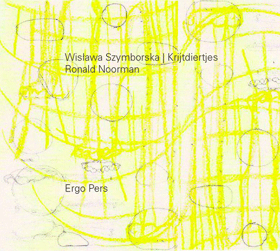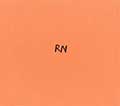| |
| |
|
|
 |
|

Ronald Noorman, Z.T., 2005,
krijt/houtskool/potlood, 22.8 x 29.8 cm
|
|
Ronald Noorman makes drawings. In the past, while still at the Rietveld Academie and in the years shortly thereafter, he produced graphic work.
These days, he is occasionally seen to be putting some lost property together to make it into an assemblage, but drawing is his métier. It has been for a long time. During the early eighties, when Noorman first exhibited his drawings, it was far less common for an artist to be so doggedly involved in the art of drawing than it is today - perhaps in part thanks to him? -, but it is still unusual.
Traditionally, there have been two types of draughtsmen: those who use their drawings to give form to their ideas for a painting or other work of art and those - less numerous - who engage in drawing as an autonomous activity. Noorman belongs to the second category. In the past, there have been artists, who, for a period of time and for various reasons, made drawings instead of paintings or etchings. A well-known example is Jan van Goyen: dozens, if not hundreds, of his drawings have been preserved dating from the single year 1653, whereas his paintings from that same year can be virtually counted on the fingers of one hand. Then there is Adriaen van Ostade, who in 1672, the Dutch 'Year of Disaster', sought refuge in the Amsterdam home of his patron. Since he did not have a studio at his disposal there, he made a virtue of necessity by exclusively producing drawings. Such examples are the exception, however.
Ronald Noorman, on the other hand, has chosen drawing as the primary vehicle for his imagination. What attracts him in drawing is the directness of the medium. Drawing reduces to a minimum the distance between idea, hand movement and the sign appearing on the paper, from the perspective of both time and space. The technical tools - pencil, crayon, watercolour, gouache - are a lot less inflexible than oil paint, copperplate, or stone and naturally lend themselves more easily to experimentation: failures or rejects are referred to the bin. However, drawing knows no mercy; wiping or covering up of errors is virtually impossible.
Moreover, it seems as if the viewer is able to look over the shoulder of the artists; that is how direct the contact is. The slightest hesitation, mistake or change of mind is immediately observed.
Noorman makes full use of this directness and intimacy. In the years in which he dedicated himself to the art of drawing, he developed great virtuosity, which he subsequently ignored as much as possible. His style of drawing may seem hesitant, as if he explores the image created by bis hand at touch. Sometimes the touch becomes literal: fingerprints in watercolour, pouring down like a meteoric shower on a deserted landscape [p. 160].
Coincidences may be assigned relevance and are included in the picture:
a splatter of paint or a smudge, a spot where the ball of the drawing hand has somewhat rubbed out the chalk. What strikes one, however, is the purposiveness of his style of drawing. Using minimal means, he wishes to show what occupies him, express the feeling underlying each sheet. Each drawing, he says, is an attempt to find out how far he can go - and then attempt to do it with less. Thus, a splendid oeuvre has been created, in which, with equal measures of caution and consistency, an individual language is developed to give shape to feelings and ideas that cannot be put into words.
(...)
Read more
Carel van Tuyll van Serooskerken, Chef du département des Arts graphiques du musée du Louvre. In Ronald Noorman, Tekeningen, Drawings, Zeichnungen, Galerie Nouvelles Images, The Hague, 2004. |
|
| |
|
|
Website Ronald Noorman | www.ronaldnoorman.nl |
| |
|
|
|
| |
|
| |
Ronald Noorman in Museum De Pont, Tilburg, 2011 |
| |
|
|
|
| |
|
|
Ronald Noorman, (1951, Hillversum) lives and works in Amsterdam.
1974-1978 Gerrit Rietveld Academie, Amsterdam.
Is represented by Galerie Espace (Amsterdam), Galerie Nouvelles Images (The Hague), Galerie Werner Klein (Cologne), Galerie Bismarck (Bremen).
In 2011 Ronald Noorman is showing new drawings in Stichting De Pont Tilburg.
S O L A C E - works on paper | 24 September - 20 November 2011 |
| |
|
|
|
| |
|
|
|
| |
|
|
 |
| |
|
|
|
| |
 Krijtdiertjes, (Otwornice) with poetry by Wislawa Szymborska, Krijtdiertjes, (Otwornice) with poetry by Wislawa Szymborska,
and lithography by Ronald Noorman
(first draft of the cover) |
|
In 2012 Ergo Pers published a limited edition artist's book with Nobel Prize winner Wislawa Szymborska and Ronald Noorman, in which the minimalism of Noorman is juxtaposed to the wit and deceptive simplicity of Szymborska's poetry.
Well-known in her native Poland, Wislawa Szymborska received international recognition when she won the Nobel Prize for Literature in 1996. In awarding the prize, the Academy praised her “poetry that with ironic precision allows the historical and biological context to come to light in fragments of human reality.”
Museum De Pont | March 18, 14 00 | Presentation of Krijtdiertjes, a limited edition artist's book with poems by Wislawa Szymborska and prints by Ronald Noorman.
In the New York Times Book Review, Stanislaw Baranczak wrote, “The typical lyrical situation on which a Szymborska poem is founded is the confrontation between the directly stated or implied opinion on an issue and the question that raises doubt about its validity. The opinion not only reflects some widely shared belief or is representative of some widespread mind-set, but also, as a rule, has a certain doctrinaire ring to it: the philosophy behind it is usually speculative, anti-empirical, prone to hasty generalizations, collectivist, dogmatic and intolerant.
  
  
Krijtdiertjes (Otwornice) is published by Ergo Pers in a limited edition of 40 copies, numbered and signed by the artist. Four lithographs in the book + a suite of five loose prints, signed and numbered by Ronald Noorman. Letterpress printing and manual binding by Rein Ergo, Gent; lithographs printed by Felix Bauer, Cologne. The poems were selected by both the artist and the author. The entire edition was printed on Hahnemühle 230 g. 36 x 32 cm, slipcase.
Introduction price 850 €.
Watch the book online | pdf
Museum De Pont
Wilhelminapark 1
5041 EA Tilburg
Opening hours
Tuesday through Sunday 11 am - 5 pm
Szymborska is the author of more than fifteen books of poetry. Her collections available in English include Monologue of a Dog (Harcourt, 2005), Miracle Fair: Selected Poems of Wislawa Szymborska (Norton, 2001), Poems, New and Collected, 1957-1997 (Harcourt, 1998), View with a Grain of Sand: Selected Poems(Harcourt, 1995), People on a Bridge (Forest, 1990) and Sounds, Feelings Thoughts: Seventy Poems (Princeton UP, 1981). She is also the author of Nonrequired Reading (Harcourt, 2002), a collection of prose pieces.
Wislawa Szymborska received international recognition when she won the Nobel Prize for Literature in 1996. In awarding the prize, the Academy praised her “poetry that with ironic precision allows the historical and biological context to come to light in fragments of human reality.”
Wislawa Szymborska died on February 1, 2012 at the age of 88, a few weeks before Otwornice was finished.
|
| |
|
|
|
| |
 Ronald Noorman, etching for Sur place, Ergo Pers, 2006
Ronald Noorman, etching for Sur place, Ergo Pers, 2006 |
|
Ronald Noorman, four etchings for Sur Place, a 'livre de peintre', with poetry by Hans Faverey.
Ergo Pers 2006, four etchings signed and numbered by the artist. 750 Euro’s.

|
| |
|
|
Negende Eeuw, a 'livre de peintre', with poetry by H. H. ter Balkt and five etchings by Ronald Noorman.
Ergo Pers 2008, five etchings signed and numbered by the artist ,48 pages, 28 cm x 32 cm. In slipcase, 750 Euro’s.

  
Listen to H. H. ter Balkt reafing Negende Eeuw
|
| |
|
|
Tourniquets, with two lithographs by Ronald Noorman. Edition: 50.
Ronald Noorman, ‘Tourniquets’, Ergo Pers 2009, 30,5 x 25 cm. 350 Euro’s.
|
| |
 |
|
 
|
| |
|
|

|
| |
|
|
Ronald Noorman, Tekeningen, Drawings, Zeichnungen, Galerie Nouvelles Images, The Hague, 2004. Texts by Erik Bos,Tijs Goldschmidt and Carel van Tuyll Serooskerken.
750 copies, 50 signed and numbered by the artist. |
| |
|
|
|
| |
|
|







|
| |
|
|
|
| |
|
|
|
| |
 |
|
 |
| |
|
|
|
| |
|
|
|
| |
|
|
|
| |
|
|
|
| |
|
|
|
|
